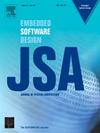Efficient two-party Private Set Union and circuit-based version for large-scale data set based on novel oblivious filter
IF 4.1
2区 计算机科学
Q1 COMPUTER SCIENCE, HARDWARE & ARCHITECTURE
引用次数: 0
Abstract
Private Set Union (PSU) protocol enables secure computation of set unions across multiple parties while preserving input privacy — a critical capability for large-scale data aggregation. To date, two-party PSU schemes predominantly adopt the “split-then-execute” paradigm, which as demonstrated by Jia et al. (2024), inherently suffers from during-execution leakage. While their proposed symmetric-key approach addresses this vulnerability, the dependency on private equality test (PET) protocol additionally introduces non-negligible computational and communication overheads. Meanwhile, research on circuit-PSU protocol capable of securely computing a function (merge, sort or federated learning) over the union set remains blank.
In this paper, we focus on two main objectives: (1) We present an optimized two-party PSU protocol that eliminates during-execution leakage while achieving enhanced efficiency; (2) We propose the first circuit-PSU. Unlike conventional PSU where participant obtains plaintext result, circuit-PSU provides secret-shared outputs that inherently prevent both during-execution leakage and intersection cardinality exposure. Furthermore, circuit-PSU removes the requirement for predefined result recipient and thus can offer superior flexibility. Meanwhile, our technical innovations include an optimized Share Translation (ShareTrans) protocol and a novel Oblivious Filter (OF) primitive that synergistically enhance both PSU and circuit-PSU efficiency. The experimental results indicate that under constrained computational resources (8-core CPU, 16GB RAM), the proposed circuit-PSU achieves a comparatively better improvement in communication complexity compared to existing state-of-the-art schemes, and our two-party PSU also exhibits comparable performance, for example, achieving approximately efficiency improvement over Jia et al. (2024).
基于新型遗忘滤波器的大规模数据集的高效两方私有集联合和基于电路的版本
私有集联合(PSU)协议在保护输入隐私的同时,支持跨多方集联合的安全计算,这是大规模数据聚合的关键能力。迄今为止,双方PSU方案主要采用“分裂-然后执行”范式,正如Jia等人(2024)所证明的那样,这种模式固有地存在执行期间泄漏的问题。虽然他们提出的对称密钥方法解决了这个漏洞,但对私相等测试(PET)协议的依赖还引入了不可忽略的计算和通信开销。同时,对于能够在联合集上安全计算函数(合并、排序或联邦学习)的circuit-PSU协议的研究仍然是空白。在本文中,我们主要关注两个主要目标:(1)我们提出了一种优化的双方PSU协议,该协议在实现提高效率的同时消除了执行过程中的泄漏;(2)我们提出了第一种电路——psu。与参与者获得明文结果的传统PSU不同,电路PSU提供秘密共享输出,固有地防止执行期间泄漏和交叉基数暴露。此外,电路psu消除了对预定义结果接收器的要求,因此可以提供更高的灵活性。同时,我们的技术创新包括一个优化的共享转换(ShareTrans)协议和一个新的遗忘滤波器(OF)原语,协同提高PSU和电路-PSU效率。实验结果表明,在有限的计算资源(8核CPU, 16GB RAM)下,与现有的最先进方案相比,所提出的电路-PSU在通信复杂性方面取得了相对更好的改进,并且我们的两方PSU也表现出相当的性能,例如,与Jia等人(2024)相比,实现了大约4倍的效率提高。
本文章由计算机程序翻译,如有差异,请以英文原文为准。
求助全文
约1分钟内获得全文
求助全文
来源期刊

Journal of Systems Architecture
工程技术-计算机:硬件
CiteScore
8.70
自引率
15.60%
发文量
226
审稿时长
46 days
期刊介绍:
The Journal of Systems Architecture: Embedded Software Design (JSA) is a journal covering all design and architectural aspects related to embedded systems and software. It ranges from the microarchitecture level via the system software level up to the application-specific architecture level. Aspects such as real-time systems, operating systems, FPGA programming, programming languages, communications (limited to analysis and the software stack), mobile systems, parallel and distributed architectures as well as additional subjects in the computer and system architecture area will fall within the scope of this journal. Technology will not be a main focus, but its use and relevance to particular designs will be. Case studies are welcome but must contribute more than just a design for a particular piece of software.
Design automation of such systems including methodologies, techniques and tools for their design as well as novel designs of software components fall within the scope of this journal. Novel applications that use embedded systems are also central in this journal. While hardware is not a part of this journal hardware/software co-design methods that consider interplay between software and hardware components with and emphasis on software are also relevant here.
 求助内容:
求助内容: 应助结果提醒方式:
应助结果提醒方式:


